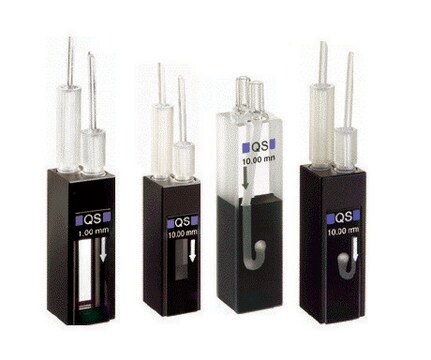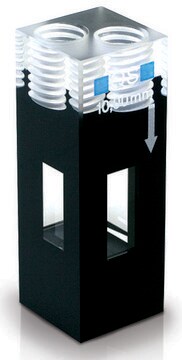Z805939
Hellmanex™ III
Special Cleaning Concentrate for cuvettes
Synonym(s):
III-Grade Laboratory Detergent
Sign Into View Organizational & Contract Pricing
Select a Size
All Photos(1)
Select a Size
Change View
About This Item
UNSPSC Code:
12000000
NACRES:
SB.32
Recommended Products
packaging
pkg of 1 L (PE bottle)
manufacturer/tradename
Hellma
technique(s)
UV/Vis spectroscopy: suitable
photometry: suitable
General description
Hellmanex III significantly reduces the surface tension of water. The removal of dirt particles is also assured by the good wetting action of a Hellmanex III aqueous solution, while its high emulsifying and dispersing capabilities prevent the redeposition of the loosened particles. Special surface-active substances facilitate the residue-free rinsing of the optical components once they have been cleaned.
Hellmanex III is filtered to 1 μm and is therefore virtually free of solid particles.
Hellmanex III is filtered to 1 μm and is therefore virtually free of solid particles.
Application
The optimal dilution (usually 0.5 to 2 vol-%) depends on several factors, such as the hardness of the water, the degree and type of contamination, the temperature, etc. The use of demineralised water improves the cleaning characteristics.
An increase in temperature speeds up the cleaning process. However, at high temperatures it is necessary to avoid thermal shock. The cells should be pre-warmed before being submerged into hot cleaning solutions.
Hellmanex III, when diluted to its working concentration of 2%, is suitable for use with glass, quartz, sapphire, porcelain, ceramics, plastics, and ferrous metals. It can also be used, with some limitations, on metals that are sensitive to corrosion such as aluminium and other non-ferrous metals. In such cases, avoid prolonged application. In the case of materials not listed here, suitability tests should be carried out or enquiries directed to Hellma.
The concentrate can be stored in vessels made of stainless steel, PE, PP, PVC, FPM, or NBR.
An increase in temperature speeds up the cleaning process. However, at high temperatures it is necessary to avoid thermal shock. The cells should be pre-warmed before being submerged into hot cleaning solutions.
Hellmanex III, when diluted to its working concentration of 2%, is suitable for use with glass, quartz, sapphire, porcelain, ceramics, plastics, and ferrous metals. It can also be used, with some limitations, on metals that are sensitive to corrosion such as aluminium and other non-ferrous metals. In such cases, avoid prolonged application. In the case of materials not listed here, suitability tests should be carried out or enquiries directed to Hellma.
The concentrate can be stored in vessels made of stainless steel, PE, PP, PVC, FPM, or NBR.
Legal Information
Hellmanex is a trademark of Hellma GmbH
signalword
Danger
hcodes
Hazard Classifications
Eye Dam. 1 - STOT SE 3
target_organs
Respiratory system
Storage Class
12 - Non Combustible Liquids
wgk_germany
WGK 1
flash_point_f
Not applicable
flash_point_c
Not applicable
Choose from one of the most recent versions:
Certificates of Analysis (COA)
Lot/Batch Number
It looks like we've run into a problem, but you can still download Certificates of Analysis from our Documents section.
If you need assistance, please contact Customer Support.
Already Own This Product?
Find documentation for the products that you have recently purchased in the Document Library.
Customers Also Viewed
Stefan Niekamp et al.
The EMBO journal, 38(13), e101414-e101414 (2019-07-04)
The movement of a molecular motor protein along a cytoskeletal track requires communication between enzymatic, polymer-binding, and mechanical elements. Such communication is particularly complex and not well understood in the dynein motor, an ATPase that is comprised of a ring
Doug K Tischer et al.
eLife, 8 (2019-04-06)
T cells are thought to discriminate self from foreign peptides by converting small differences in ligand binding half-life into large changes in cell signaling. Such a kinetic proofreading model has been difficult to test directly, as existing methods of altering
Sudha Kumari et al.
The EMBO journal, 39(5), e102783-e102783 (2020-01-03)
When migratory T cells encounter antigen-presenting cells (APCs), they arrest and form radially symmetric, stable intercellular junctions termed immunological synapses which facilitate exchange of crucial biochemical information and are critical for T-cell immunity. While the cellular processes underlying synapse formation
Stefan Niekamp et al.
Proceedings of the National Academy of Sciences of the United States of America, 116(10), 4275-4284 (2019-02-17)
Light microscopy is a powerful tool for probing the conformations of molecular machines at the single-molecule level. Single-molecule Förster resonance energy transfer can measure intramolecular distance changes of single molecules in the range of 2 to 8 nm. However, current
Our team of scientists has experience in all areas of research including Life Science, Material Science, Chemical Synthesis, Chromatography, Analytical and many others.
Contact Technical Service











